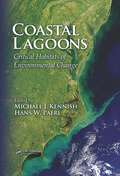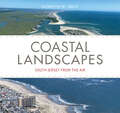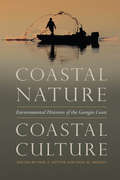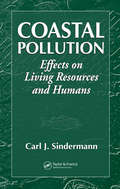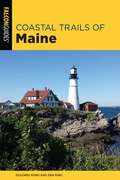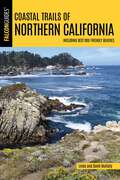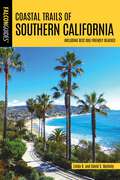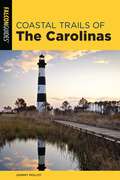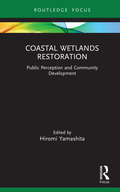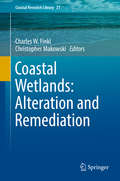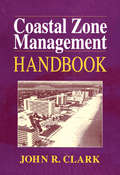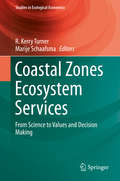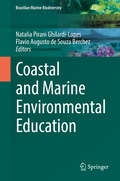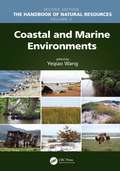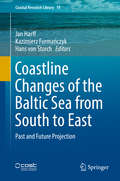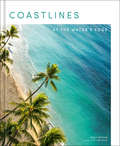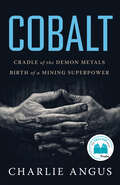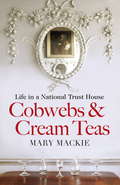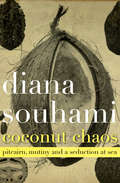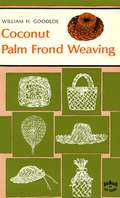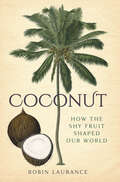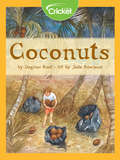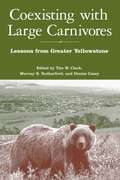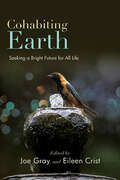- Table View
- List View
Coastal Lagoons: Critical Habitats of Environmental Change (ISSN)
by Michael J. Kennish Hans W. PaerlWritten by an outstanding group of contributors, this book examines the function and structure of coastal lagoonal ecosystems and the natural and anthropogenic drivers of change that affect them, most notably nutrient over-enrichment from coastal watersheds and airsheds. The contributors target the susceptibility of coastal lagoons to eutrophication, the indicators of eutrophic conditions, the influences of natural factors such as major storms and other climate effects, and the resulting biotic and ecosystem impairments that have developed. The book compares biogeochemical and ecological response to nutrient enrichment and other pollutants in lagoonal estuaries to those in other estuarine types.
Coastal Landscapes: South Jersey from the Air
by Kenneth W. AbleNew Jersey has roughly one hundred and thirty miles of coastline, including a wide array of habitats from marshes to ocean beaches, each hosting a unique ecosystem. Yet these coastal landscapes are quite dynamic, changing rapidly as a result of commercial development, environmental protection movements, and of course climate change. Now more than ever, it is vital to document these landscapes before they disappear. Based on numerous aerial images from helicopter and drone flights between 2015 and 2021, this book provides extensive photographs and maps of the New Jersey coast, from the Pine Barrens to the ocean beaches. The text associated with each exceptional image describes it in detail, including its location, ecological setting, and relative position within the larger landscape. Author Kenneth Able, director of the Rutgers University Marine Field Station for over thirty years, has thoroughly ground-truthed each image by observations made through kayaks, boats, and wading through marshes. Calling upon his decades of expertise, Able paints a compelling portrait of coastal New Jersey’s stunning natural features, resources, history, and possible futures in an era of rising sea levels.
Coastal Nature, Coastal Culture: Environmental Histories of the Georgia Coast (Environmental History and the American South)
by Paul S. Sutter; Paul M. PresslyAn essay collection exploring the history of 5,000-year relationship between human culture and nature on the Georgia coast. One of the unique features of the Georgia coast today is its thorough conservation. At first glance, it seems to be a place where nature reigns. But another distinctive feature of the coast is its deep and diverse human history. Indeed, few places that seem so natural hide so much human history. In Coastal Nature, Coastal Culture, editors Paul S. Sutter and Paul M. Pressly have brought together work from leading historians as well as environmental writers and activists that explores how nature and culture have coexisted and interacted across five millennia of human history along the Georgia coast, as well as how those interactions have shaped the coast as we know it today. The essays in this volume examine how successive communities of Native Americans, Spanish missionaries, British imperialists and settlers, planters, enslaved Africans, lumbermen, pulp and paper industrialists, vacationing northerners, Gullah-Geechee, nature writers, environmental activists, and many others developed distinctive relationships with the environment and produced well-defined coastal landscapes. Together these histories suggest that contemporary efforts to preserve and protect the Georgia coast must be as respectful of the rich and multifaceted history of the coast as they are of natural landscapes, many of them restored, that now define so much of the region.Contributors: William Boyd, S. Max Edelson, Edda L. Fields-Black, Christopher J. Manganiello, Tiya Miles, Janisse Ray, Mart A. Stewart, Drew A. Swanson, David Hurst Thomas, and Albert G. Way.
Coastal Pollution: Effects on Living Resources and Humans
by Carl J. SindermannIn 1996, after more than a decade of researching the effects of over-population and the consequent pollution of the greater metropolitan New York City area, Carl Sindermann published his observations and conclusions in Ocean Pollution: Effects on Living Resources and Humans, a mostly technical document that emphasized the pathological effects of co
Coastal Trails of Maine: Including Acadia National Park
by Dolores Kong Dan RingMaine has one of the longest coastlines in the United States (by one estimation even exceeding that of California), and with nearly 55% of the state&’s population living in a coastal county the Maine coast remains a popular and populated area of the northeast. Coastal Trails of Maine celebrates this vibrant region by offering the best hikes along Maine&’s gorgeous coast. Written by local experts and NOBA winners, Dolores Kong and Dan Ring, Coastal Trails of Maine will offer everything hikers will need to explore this treasured shoreline.
Coastal Trails of Northern California: Including Best Dog Friendly Beaches
by Linda Mullally David MullallyCoastal Trails of Northern California Including Best Dog Friendly Beaches is a hiking guide to between 40 and 45 of the best coastal trails in Northern California including dog friendly beaches. Look inside for detailed hike descriptions, miles and directions, maps, and color photos for each hike. Hike descriptions also include history, local trivia, and trailhead GPS coordinates.
Coastal Trails of Southern California: Including Best Dog Friendly Beaches
by Linda Mullally David MullallyCoastal Trails of Southern California Including Best Dog Friendly Beaches is a hiking guide to between 40 and 45 of the best coastal trails in Southern California including dog friendly beaches. Look inside for detailed hike descriptions, miles and directions, maps, and color photos for each hike. Hike descriptions also include history, local trivia, and trailhead GPS coordinates.
Coastal Trails of the Carolinas
by Johnny MolloyWith hundreds of miles of beautiful beaches and barrier islands, the coastline of North and South Carolina is one of the most treasured shorelines in the country. Coastal Trails of the Carolinas celebrates this vibrant region by offering the best hikes along this gorgeous coast. Written by veteran guidebook author Johnny Molloy and including additional information on local sights and attractions, Coastal Trails of the Carolinas will offer everything hikers need to explore this treasured shoreline.
Coastal Wetlands Restoration: Public Perception and Community Development (Routledge Focus on Environment and Sustainability)
by Hiromi YamashitaThis book examines a wide range of innovative approaches for coastal wetlands restoration and explains how we should use both academic research and practitioners’ findings to influence learning, practice, policy and social change. For conservationists, tidal flats and coastal wetlands are regarded as among the most important areas to conserve for the health of the entire oceanic environment. As the number of restoration projects all over the world increases, this book provides a unique assessment of coastal wetland restorations by examining existing community perceptions and by drawing on the knowledge and expertise of both academics and practitioners. Based on a four-year sociological study across three different cultural settings – England, Japan and Malaysia – the book investigates how citizens perceive the existing environment; how they discuss the risks and benefits of restoration projects; how perceptions change over time; and how governmental and non-governmental organisations work with the various community perceptions on the ground. By comparing and contrasting the results from these three countries, the book offers guidance for future conservation and restoration activities, with a specific view to working with local citizens to avoid conflict and obtain long-term investment. This book will be of great interest to students and scholars of coastal restoration, wetland conservation and citizen science, as well as environmental sociology and environmental management more broadly. It will also be of use to practitioners and policymakers involved in environmental restoration projects.
Coastal Wetlands: Alteration and Remediation (Coastal Research Library #21)
by Charles W. Finkl Christopher MakowskiThis book delves into human-induced and natural impacts on coastal wetlands, intended or otherwise, through a series of vignettes that elucidate the environmental insults and efforts at amelioration and remediation. The alteration, and subsequent restoration, of wetland habitats remain key issues among coastal scientists. These topics are introduced through case studies and pilot programs that are designed to better understand the best practices of trying to save what is left of these fragile ecosystems. Local approaches, as well as national and international efforts to restore the functionality of marsh systems are summarily approached and evaluated by their efficacy in producing resilient reclamations in terms of climate-smart habitat conservation. The outlook of this work is global in extent and local by intent. Included here in summarized form are professional opinions of experts in the field that investigate the crux of the matter, which proves to be human pressure on coastal wetland environments. Even though conservation and preservation of these delicate environmental systems may be coming at a later date, many multi-pronged approaches show promise through advances in education, litigation, and engineering to achieve sustainable coastal systems. The examples in this book are not only of interest to those working exclusively with coastal wetlands, but also to those working to protect the surrounding coastal areas of all types.
Coastal Zone Management Handbook
by John R. ClarkCoastal Zone Management Handbook comprises the first complete manual on coastal resource planning and management technology. Written by an international consultant, this handbook reflects a global perspective on the natural resources, sensitivities, economics, development, productivity, and diversity of coastal zones. The emphasis is on tropical and subtropical coastal ecosystems, but the information is widely applicable. In addition to its comprehensive coverage of general concepts related to coastal regions, the book describes the strategic basis for coastal management, provides a set of working tools for management and planning activities, and presents case histories of management projects around the globe. Extensive references are provided for each management analysis, practice, technique, and solution. Coastal Zone Management Handbook is made up of four sections:
Coastal Zones Ecosystem Services: From Science to Values and Decision Making (Studies in Ecological Economics #9)
by R. Kerry Turner Marije SchaafsmaThis book applies the 'ecosystem services' framework to coastal environments, showing how it could facilitate an adaptive management strategy. The contributors describe a decision support system (DSS) based on the 3 Ps - pluralism, pragmatism and precaution - that leads to a more flexible, 'learn by doing' approach to the stewardship of coastal environments. The book lays out a "Balance Sheets Approach" to formatting, interrogating and presenting data and findings. The opening chapter defines coastal zones, their characteristics and natural resources, and describes their complex and dynamic nature. The chapter shows that large-scale trends and pressures have led to a global loss of 50% of marshes, leading to significant declines in biodiversity and habitat. Part I presents a conceptual framework, describes natural science techniques for coastal and shelf modeling, and describes valuation of ecosystem services. Part II outlines practical ecosystem indicators for coastal and marine ecosystem services, reviews literature on valuation of coastal and marine ecosystem services, explores scenarios, outlines marine and coastal ecosystem services data and offers tools for incorporating data into decision-making. PART III offers case studies including one linking the ecosystem services of Marine Protected Areas to benefits in human wellbeing; and another on valuing blue carbon captured by oceans and coastal ecosystems. Also included are a study of managed realignments and the English coastline and their value estimate transferability; and studies of the impact of jellyfish blooms on recreation in the UK and on fisheries in Italy.
Coastal and Marine Environmental Education (Brazilian Marine Biodiversity)
by Natalia Pirani Ghilardi-Lopes Flavio Augusto BerchezThis book provides a broad overview of how the promotion of ocean and coastal literacy is being planned, applied and evaluated in Brazil, a country of continental dimensions with a great diversity of cultural, educational and social realities. It discusses a range of target groups, from children to adults; formal and informal strategies; and various promoting players, such as groups/institutions. Researchers representing Brazilian academic institutions and NGOs share their environmental education (EE) experiences in Brazil and describe the main concerns regarding the marine and coastal environments as well as how they are addressing these concerns in their EE projects. This book is of interest to anyone who is looking for ways of designing and implementing EE activities with a robust theoretical background in different socio-cultural scenarios.
Coastal and Marine Environments
by Yeqiao WangAuthored by world-class scientists and scholars, The Handbook of Natural Resources, Second Edition, is an excellent reference for understanding the consequences of changing natural resources to the degradation of ecological integrity and the sustainability of life. Based on the content of the bestselling and CHOICE-awarded Encyclopedia of Natural Resources, this new edition demonstrates the major challenges that the society is facing for the sustainability of all well-being on the planet Earth. The experience, evidence, methods, and models used in studying natural resources are presented in six stand-alone volumes, arranged along the main systems of land, water, and air. It reviews state-of-the-art knowledge, highlights advances made in different areas, and provides guidance for the appropriate use of remote sensing and geospatial data with field-based measurements in the study of natural resources. Volume 5, Coastal and Marine Environments, discusses marine and coastal ecosystems, their biodiversity, conservation, and integrated marine management plans. It provides fundamental information on coastal and estuarine systems and includes discussions on coastal erosion and shoreline change, natural disasters, evaporation and energy balance, fisheries and marine resource management, and more. New in this edition are discussions on sea level rise, renewable energy, coral reef restoration, fishery resource economics, and coastal remote sensing. This volume demonstrates the key processes, methods, and models used through many case studies from around the world. Written in an easy-to-reference manner, The Handbook of Natural Resources, Second Edition, as individual volumes or as a complete set, is an essential reading for anyone looking for a deeper understanding of the science and management of natural resources. Public and private libraries, educational and research institutions, scientists, scholars, and resource managers will benefit enormously from this set. Individual volumes and chapters can also be used in a wide variety of both graduate and undergraduate courses in environmental science and natural science at different levels and disciplines, such as biology, geography, earth system science, and ecology.
Coastline Changes of the Baltic Sea from South to East: Past and Future Projection (Coastal Research Library #19)
by Hans Von Storch Jan Harff Kazimierz FurmańczykThe book discusses sea-level and coastline changes which are becoming increasingly important topics for the population living along the edge of the world's oceans and seas. These topics are of special importance where eustatic sea-level rise is superimposed by isostatic subsidence and storm induced coastal erosion. This is the case at the southern and eastern Baltic Sea coast: In the South, where glacio-isostatic subsidence enhances the effect of climate induced sea-level rise and strong storm effects cause a continuous retreat of the coast. At the eastern coast the glacio-isostatic uplift compensates eustatic sea-level rise, but storm induced waves cause permanent morphodynamic changes of the coastline. There is an increasing need for concepts for protection, for defense but also for the economic use of the different types of coastal zones. The elaboration of those management concepts can be facilitated through models that generate future projections of coastal developments in front of the modern climate change. The proposed anthology comprises results of the research project "Coastline Changes of the southern Baltic Sea - Past and future projection (CoPaF)" which was ran by a team of Estonian, German, and Polish geoscientists and coastal engineers from 2010 to 2013. As the southern and eastern Baltic serves as a natural laboratory for the investigation of coastal processes - the achievements of the project shall contribute not only to the solution of regional problems in Baltic coastal research and engineering, but, shall be regarded as a contributions to general foci of description, modelling and parameterization of coastal processes and morphodynamics.
Coastlines: At the Water's Edge
by Emily NathanA wanderlust-inspiring photography collection of the world&’s most stunning waterways and coastlines from the premier online curator of travel photography, Tiny Atlas Quarterly. From tropical beaches in Hawai&’i and icy fjords in Greenland to lush mangrove swamps in the Cuban Cayos and forested islands in Vietnam, coastlines and waterways are some of the world&’s most beloved places and most precious habitats. With hundreds of awe-inspiring photos from locations far and wide, Coastlines is a visual tour of these magical watery places and a treasure trove of curated travel information. Water lovers, beach bums, and armchair travelers will enjoy this tranquil exploration of the world&’s many vast and varied shores.
Cobalt: The Making of a Mining Superpower
by Charlie AngusThe world is desperate for cobalt. It drives the proliferation of digital and clean technologies. But this “demon metal” has a horrific present and a troubled history. The modern search for cobalt has brought investors back to a small town in Northern Canada, a place called Cobalt. Like the demon metal, this town has a dark and turbulent history. The tale of the early-twentieth-century mining rush at Cobalt has been told as a settler’s adventure, but Indigenous people had already been trading in metals from the region for two thousand years. And the events that happened here — the theft of Indigenous lands, the exploitation of a multicultural workforce, and the destruction of the natural environment — established a template for resource extraction that has been exported around the world. Charlie Angus reframes the complex and intersectional history of Cobalt within a broader international frame — from the conquistadores to the Western gold rush to the struggles in the Democratic Republic of Congo today. He demonstrates how Cobalt set Canada on its path to become the world’s dominant mining superpower.
Cobwebs and Cream Teas
by Mary MackieA warm and funny account of what it is like to live in and run a National Trust house: Felbrigg Hall in Norfolk.When Mary Mackie's husband became Houseman at Felbrigg Hall in Norfolk she suddenly found herself running one of the most elegant 17th-century houses in East Anglia. During their first year living in the National Trust house she was endlessly running up and down corridors, making visitors welcome, keeping unwelcome visitors at bay, arranging concerts, dinners and vast cleaning programmes. But leavening all the hard work were the exciting discoveries - hidden staircases, treasures in the attic and an ice house in the woods. COBWEBS AND CREAM TEAS reveals the tribulations and excitement that occur in any house open to the public, and it assures us that living in a National Trust house provides only the certainty that life will never be dull, or idle, again.
Cobwebs and Cream Teas
by Mary MackieA warm and funny account of what it is like to live in and run a National Trust house: Felbrigg Hall in Norfolk.When Mary Mackie's husband became Houseman at Felbrigg Hall in Norfolk she suddenly found herself running one of the most elegant 17th-century houses in East Anglia. During their first year living in the National Trust house she was endlessly running up and down corridors, making visitors welcome, keeping unwelcome visitors at bay, arranging concerts, dinners and vast cleaning programmes. But leavening all the hard work were the exciting discoveries - hidden staircases, treasures in the attic and an ice house in the woods. COBWEBS AND CREAM TEAS reveals the tribulations and excitement that occur in any house open to the public, and it assures us that living in a National Trust house provides only the certainty that life will never be dull, or idle, again.
Coconut Chaos: Pitcairn, Mutiny and a Seduction at Sea
by Diana SouhamiA unique travelogue in which the author journeys to Pitcairn Island—of Mutiny on the Bounty fame—with detours to eighteenth-century Tahiti and beyond. It started with a coconut . . . In the early hours of April 27, 1789, Fletcher Christian, master&’s mate on the HMS Bounty, took a coconut from a pile on the quarterdeck. This random, seemingly inconsequential act set in motion a snowballing series of events that culminated in a revolt. In this strikingly original book, equal parts travelogue, memoir, and time-travel adventure, Diana Souhami moves across time and place, from eighteenth-century Tahiti to modern-day Pitcairn Island, from Knightsbridge to Tauranga, Mangareva to Tubuai. Along with Fletcher Christian, the sprawling cast of characters includes the unforgettable Captain William Bligh, who is cast adrift in an open boat on ferocious seas with eighteen men and no maps or supplies. Along the way, Souhami also introduces us to Pitcairn Island sex offenders, the Native American crew of a seventeen-thousand-ton ship called the Tundra Princess, her own elderly mother, and a mysterious lesbian aristocrat known as Lady Myre. Weaving together history, destiny, and chaos theory, this captivating adventure is for anyone who has ever yearned to travel to an exotic, faraway place.
Coconut Palm Frond Weaving
by William H. Goodloe Ellen GoodloeLearn the art of palm weaving with this fun Hawaiian craft book.Based on years of meticulous study and practice, the book explains in clear, easy-to understand instructions how to obtain and prepare coconut palm fronds suitable for weaving into hats, baskets, epergnes, mats, birds, and various decorations. More than 100 easy-to-follow diagrams and sketches give the reader exact, detailed instructions on weaving procedures, and provide countless ideas to inspire the imagination of the creator. After mastering the basic principles of frond weaving, the reader will be able to duplicate almost any woven object or execute his own designs, whether in coconut palm fronds or with fronds from other types of palm trees and palmettos.The weaving itself takes no unusual physical prowess. In fact, frond weaving is well suited to the needs of both recreational craft and physical therapy programs, as well as the general hobbyist. With a little patience and effort, a novice weaver can acquire the skills of an ancient art which is as uncomplicated as it is beautiful.This economical and delightfully presented volume will be a valued addition to the literature of traditional handicrafts, a book that recreation libraries and all craft enthusiasts will welcome.
Coconut: How the Shy Fruit Shaped our World
by Robin LauranceCoconuts have been around for longer than Homo sapiens; they have been turned into art, taken part in religious rituals and been a sign of wealth and success. They have saved lives, not only by providing nourishment, but also as part of the charcoal filers in First World War gas masks. It was coconuts that triggered the mutiny on the Bounty, and coconuts that saved the life of the man who went on to become the 35th President of the United States. The coconut has long been the unseen player in the endeavours of industrialists and bomb makers, physicians and silversmiths, smugglers and snake charmers. To this day, coconuts shape the lives of people around the world. At a time when coconut products crowd the shelves of supermarkets, health food shops and beauty salons, Robin Laurance looks beyond the oils and health drinks to uncover the unexpected, often surprising, and vital roles played by the coconut palm and its nut in times past and present.
Coconuts
by Dagmar KostJason helps his family prepare for hurricane Calvin. At first, he thinks his job to pick up coconuts is just because he's little and had to stay out of everybody's way. But then he learns how dangerous coconuts can be in a hurricane.
Coexisting with Large Carnivores: Lessons From Greater Yellowstone
by Murray Rutherford Denise Casey Tim ClarkAs in the rest of the United States, grizzly bears, wolves, and mountain lions in and around Yellowstone National Park were eliminated or reduced decades ago to very low numbers. In recent years, however, populations have begun to recover, leading to encounters between animals and people and, more significantly, to conflicts among people about what to do with these often controversial neighbors. Coexisting with Large Carnivores presents a close-up look at the socio-political context of large carnivores and their management in western Wyoming south of Yellowstone National Park, including the southern part of what is commonly recognized as the Greater Yellowstone Ecosystem. The book brings together researchers and others who have studied and worked in the region to help untangle some of the highly charged issues associated with large carnivores, their interactions with humans, and the politics that arise from those interactions. This volume argues that coexistence will be achieved only by a thorough understanding of the human populations involved, their values, attitudes, beliefs, and the institutions through which carnivores and humans are managed. Coexisting with Large Carnivores offers important insights into this complex, dynamic issue and provides a unique overview of issues and strategies for managers, researchers, government officials, ranchers, and everyone else concerned about the management and conservation of large carnivores and the people who live nearby.
Cohabiting Earth: Seeking a Bright Future for All Life
by Joe Gray; Eileen CristThe eco-catastrophes that we are witnessing today starkly demonstrate how the interests of the Earth's currently dominant species are in lockstep with those of nature's wider whole. Simply stated, humans and the more-than-human world have a shared fate. Just as humanity's unrestrained overreach in the ecosphere is driving a mass extinction event and causing the devastation of lifeforms and places, so it is also jeopardizing the prospect of a human future worth living. There is no "humans versus nature" tradeoff: the wellbeing of both is inseparably entwined. Solutions to the shared predicament of all Earth's beings will thus necessarily be those that strive for harmony between human presence and the rest of nature. This applies to the philosophy we adopt for agriculture, the ways in which human economies operate, our patterns of consumption, and numerous other intertwined threads of our existence. This anthology argues that harmony between humanity and our home planet must be built on the pillars of restraint, respect, and reverence.
